Since it’s been nearly a year with no posts, I think I can officially close this blog. There remains a glimmer of hope that future long-term travels will warrant its re-opening, but for now, may it rest in peace. Au revoir!
Category: food
-
Hearts for Valentine’s Day
For Valentine’s Day this year, we happened to be in London. Hadn’t really consciously planned it that way, but once I had realized the situation, I set a goal to obtain lunch reservations at St. John Restaurant. I had heard about this place, this Legend years ago. It never struck me as a particularly spectacular food destination until I read Anthony Bourdain’s opinion that he would eat his last meal on earth here: Roast Bone Marrow and Parsley Salad.

The place is known for its offal. I borrowed The Whole Beast: Nose-to-Tail Eating, one of the restaurant’s books written by chef Fergus Henderson, from the library to research in advance the kind of snout-filled, tail-topped, chopped-ear-garnished food we would be presented with the option of eating upon arrival. Frankly, I’m not really perturbed by offal as I find most of it – barring the wretched tripe – pretty darn tasty. I’ll never pass up an opportunity to eat sweetbreads or ham hocks and, thanks to Alembic, will always order duck hearts on a menu. So the prospect of eating at a restaurant infamous for its delicate and respectable treatment of unrespected parts was intriguing.
After several attempts on OpenTable, I snagged us a spot and that became our only appointment in London. It was also the only appointment to which we arrived late. We had 3 days to get there, and we got there late. (Stupid windy streets.) Out of breath and hungry, we stepped into the simply outfitted dining room and were seated at a table almost precisely in the middle of the room with a fine view of the kitchen shenanigans.
And thus, we began the job of translating the menu into North American. The signature dish, the one that Anthony Bourdain would die eating, was what we would have to start, no question. But what is Middlewhite? What is an Arbroath Smokie? Uh… Brawn? There were actually several more things on the menu about which we had no clue so kept our waiter stuck at our table answering questions for a few minutes. (Middlewhite is a type of fatty pork. Arbroath Smokie is a smoked haddock produced only in Arbroath, Scotland. Brawn is Formula One racing team and, in Britain, a seasoned jellied loaf made from the head and sometimes the feet of a pig or calf.)
Eventually we selected the following: Roast Bone Marrow and Parsley Salad, Duck Hearts with White Beans (it was á propos for Valentine’s Day), Marc had Braised Hare with Swedes and I had the Arbroath Smokie with Parsnips and side of Mash. After all that business about nose-to-tail, we forgot to order anything pork.
The coveted bone marrow and salad arrived first accompanied by lobster-eating implements meant to be used to scoop out the mushy, luscious marrow from inside the bone. It’s eaten on toast, with a quick lash of grey sea salt and a pinch of parsley salad. I admit, it was divine- though arguably the bone marrow at Alembic is just as good, if not better. I couldn’t help the comparison! It’s all I had known of bone marrow before this! The duck hearts were lovely, but again, not as good as the jerk-spiced duck hearts with tangy pineapple at Alembic. So far, a draw.
The main courses arrived and I was presented with a whole fish to eat. With a rich, creamy sauce and a light smoky flavour, the fish permeated every taste bud and oral receptor, though not unpleasantly. As I delicately peeled the flesh back from the bone, I informed Marc that I would be smelling of smoked fish for the rest of today, and likely into tomorrow morning. For his part, Marc heroically finished his large portion of braised hare which tasted rather like lamb. I suspect that was because the hare in the UK would be different from the tasty bunnies we eat here. Intriguing, hearty, a proper filling lunch but an enlightenment, it was not. Alas, I fear I had set the bar too high.

-
More Kimchi, Please
More than a dozen little dishes or accoutrements for our “Korean BBQ for 4” and I wish they all held kimchi. Except for the one that holds the teeny dried fish.
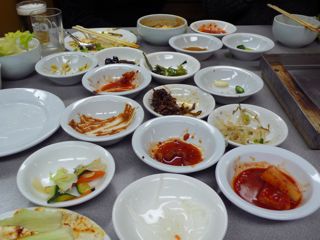

-
Simply Espresso
Since the DeLonghi espresso machine we currently use is now approaching six years of age, Marc is starting to hint at buying a new one. For every day of every year since we’ve had it (except the year spent travelling) this machine has brewed up at least two cappuccini in the morning. Marc has calculated that we’ve used it over 1ooo times. Considering I paid $40 for it, used, 6 years ago, I figure it doesn’t owe us anything. That works out to about, what, 2¢/cappuccino!? But now the seal is starting to go and it’s getting a little too finicky…
The espresso machine is actually the only thing that has a permanent home on our one small countertop. And I mean the only thing. We both have an affinity for minimalist design, so any surface area in our whole flat has minimal permanent residents. (On my desk, only the small desk lamp, the monitor and a framed print live here permanently.) So by combining the need for a new espresso machine with the requirement that it be as unobtrusive as possible, I think I’ve found a viable contender: the Stelton 898 Simply Espresso.

Pros: It’s tiny, it’s shiny, it’s European (upon this point I shall infer that it makes a decent tasting espresso), it looks really simple to use, and would take up no more than its fair share of countertop space. Because it’s battery-operated, it could even come to the breakfast table with us!
Cons: no milk frother (duh), $289, and does it only make one double shot? Must one use those wretched coffee pods? How much does it cost to replace the battery? Of course, Stelton also sells the appropriate accoutrements, including a milk frother.
This may not be the choice, but it’s fascinating to see the innovation.
-
The Omelette
Years ago, I took a cooking class that focused on eggs. Out of all the classes I have taken, I would argue that this one was the best, the most revelatory. I still think back to that day-long Saturday class in which I developed a fundamental understanding of the most versatile and elemental tool in cooking: the magnificent egg! The chef started the class by cooking scrambled eggs, and then launched into eggs benedict, a prospect that made my mouth water until she said she would be making it with bearnaise sauce instead of hollandaise. I’m sure my face visibly sagged with disappointment. I had wanted the classic experience, the purest form of eggs benedict. I wanted to witness precisely what it should be and, for me, that involved hollandaise. But had I gotten my wish, I never would have tasted bearnaise and I would never have become The Best Eggs Benedict Maker I Know. The bearnaise deserves all the credit. The perfectly poached free-range eggs, the precisely chewy English muffins, the hand-shaved black-forest ham, all of these things play a part, but it is the bearnaise that lifts the eggs benedict to its most glorious form. We don’t even order eggs benedict at restaurants anymore. What’s the point? How could it ever measure up to mine? (And with that kind of hubris, I will never again be able to poach an egg.)
More recently, I read Michael Ruhlman’s The Elements of Cooking: Translating the Chef’s Craft for Every Kitchen, or at least the non-encyclopedic part of the book, and my appreciation for the egg increased even further. He writes, “My reverence of the egg borders on religious devotion.” From that loaded introduction, he proceeds to list the reasons why the egg is the epitome of food perfection (page 22, if anyone cares to read it) and elaborates on its various methods of preparation. If ever I needed a reason to love the egg even more, this gave me a trove of pro arguments. One of things he discusses, of course, it the making of an omelette. In my Introduction to Eggs class, the chef told us all that the making of an omelette is something that many chefs use to test the skill of their potential staff, something I’ve heard echoed a few times since then. So naturally, I felt that the first skill I was going to work to perfect was the making of an omelette.
It turns out that the method which I was taught was sort of a cross between an American-style country omelette, and a classic French omelette. (Dude, I hadn’t even known there were different types of omelettes, let alone techniques.) I was taught to use a very hot, non-stick skillet, to slowly draw the large curds from the outer edges of the pan towards the center, to fold the finished omelette into three overlapping parts, and, under no circumstances, should I ever allow the bottom of the omelette to brown. This technique, I thought, was The Way To Make An Omelette. Little did I know of the variations in technique, and the incredible difference in flavour the technique can make. I mean, eggs is eggs! How different could they taste if scrambled or made into an omelettle?! Turns out: quite a bit, my friend.
Since that fateful class, I have been drawn to any and all kinds of instruction on how to make an omelette. We’ve watched the America’s Test Kitchen version, which involved using chopsticks and the broiler; I must’ve read a couple dozen of written How To’s; we’ve watched Julia Child make them, Julia & Jacques make them, Bobby Flay make them and – the latest – Jacques sans Julia make them. Truly, they are astonishingly different, these lessons. I have to say, I liked Jacques Pepin’s classic version the best even though I CAN’T STAND that he uses a metal fork to scrape the bottom of a non-stick skillet.
I think it’s fair to say that I am still developing my own style. I like the idea of using chopsticks to help swirl and scramble the eggs around the pan because it’s easy to use them as pincers to pick up the edges if need be, and I am determined to master the technique of folding it into a perfect Pepin-torpedo. I respect the knowledge of the egg that Rulman imparted and if ever the omelette turns into scrambled eggs, I adopt Julia’s attitude of “no excuses and no apologies”. Above all, I love the creamy taste of the classic French omelette, and that alone warrants the effort. It is that version that I plan to perfect, and when I do, I think I’ll buy a chef’s hat.
-
Christmas Past
Egad. How is it possible that I have forgotten to document the culinary masterpiece that was Christmas 2008? Compared to Xmas ’09, it could be described as ethereal, so how on earth could I have not written about it here on this fair-weather blog? Flipping back through the pages of my menu book, I found the record for Christmas Eve 2008 (indeed, I record the things we have eaten so that when the world ends and future generations are sifting through the tattered remains of society, they can read about what the mortals once ate and wonder, “what is agnolotti”?)
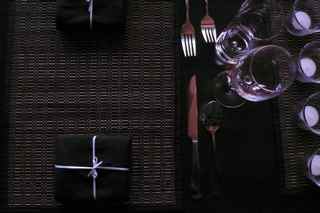
Le Menu de Noël, 2008
Cornets of Salmon Tartare with Sweet Red Onion Crème Fraîche

Chestnut Agnolotti with Fontina and Celery Root-White Truffle Purée
Dry-aged St. Helena Standing Prime Rib Roast
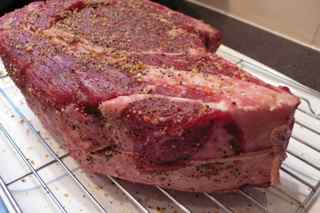
Roasted Cauliflower, Brussels Sprouts and Jerusalem Artichokes
Cheeses with Quince Paste and Walnuts
A Veil of Vanilla
Marvelous, this meal. I recall that we dragged my small desk to the living room window to act as an intimate dining table with a view of the city. I remember the trouble we went through trying to make those damn cornets without the proper (and expensive) cornet-making tools; and I remember being pretty pleased with myself at having made and rolled out the pasta for the agnolotti by hand, without the aid of a pasta maker, thank you very much! But what is most dominant in my memory of this once-per-year feast is the dessert.
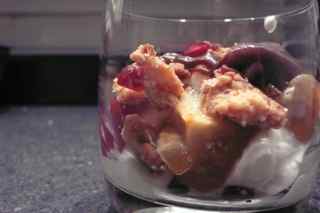
From Elizabeth Faulker’s book, A Veil of Vanilla is the name she applied to this multi-layered, somewhat deconstructed version of individual trifle-esque desserts. In two glasses, we layered dark, sweet tarte tatin apples and Point Reyes blue cheese crumble with pecan caramel sauce, Napa Wildflower Honey semifreddo, and small cubes of pomegranate gelée. Sprinkled on top were little glowing gems of fresh pomegranate seeds. Crazy good. Like the kind of good that warrants exclamations of pleasure between bites. With each recipe of hers that I try, I am tempted to label each one as The Best Dessert I Have Ever Had. Maybe I should avoid the absolute declarations of “best” or “worst” and just stick with the Continuum of Like, where “best” is something that can never physically be obtained/observed, like absolute zero. Relative that that spectrum, this dessert can certainly be classed amongst the Super-Like.
This book is like a secret weapon of desserts. It should be printed and distributed as a little red book. It should be included in a Match.com “How to Find a Soul-Mate” kit. It should be sold with a napkin as a bookmark so as to manage the drooling over the photos of confectionary.
-
From Xmas to Halloween
As has become tradition, we have cordoned off Christmas Eve for ourselves for the purposes of cooking and enjoying a multi-course, no-meat-is-too-expensive, dinner for two by the fire. It has long been the case that the food is what I anticipate the most during the Xmas season. Now that we have cultivated this new tradition of decadence, it has become the ultimate focus of my anticipation– there will be no better meal during the year than the one on December 24th.


This year, though the rules of decadence applied, we were a little less astringent in the following of the recipes‘ rules, which resulted in some near misses and, admittedly, one bonafide disaster.
Le Menu
Whole-wheat Blini with Caviar and Crème Fraîche
Sparkling white
Cauliflower Soup with Pecorino Romano and Black Truffle Oil
Spice-rubbed Roasted Squab
Homemade Potato Gnocchi in Browned-butter Sauce
Sautéed Kale
2006 Bouchaine Pinot Noir, Carneros, Napa Valley
Taleggio Raw-milk Cheese
Apple-Pomegranate Tarte Tatin with Honeyed Mascarpone
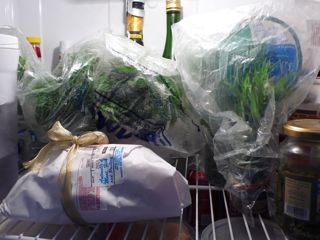
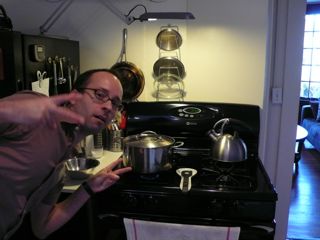
Generally speaking, it would be pretty hard not to pry a delightful evening from a menu such as this. Critically speaking, there were quite a few small mistakes we made along the way, or things that just didn’t taste “quite right” that I would do differently next time. The whole wheat in the blini overpowered the taste of caviar (which was on the cheaper side, to be sure, but we still paid good American money for that American caviar and we should have been able to taste it!); the cauliflower soup was a little bland – the cauliflower should have been roasted before being made into soup; the roasted squab (a.k.a. pigeon) was too roasted, alas, and became a little dried out; the kale, it turns out, is not something that one can sauté with garlic, like swiss chard, to produce a lovely aromatic green on the plate.
The apple-pomegranate tarte tatin was a catastrophe. We’ve made the classic tarte tatin a dozen times with great success (and fabulous leftovers) but the addition of pomegranate poisoned the formula. What started as this:
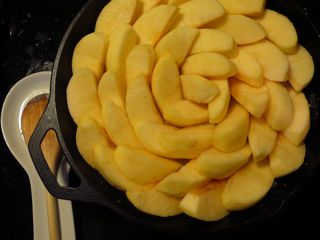
…ended up as this:
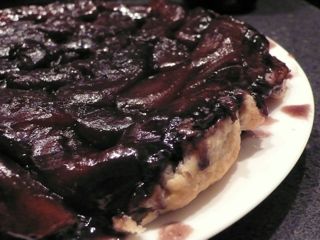
Black. Undeniably, solidly, even-viewed-in-direct-sunlight, midnight black. It seems that pomegranate adds zero to the flavour of such a tart and effectively turns the sugars and apples into pure evil if left to simmer together for a long period of time. On the plus side, it was still entirely edible, and now we have a secret formula for making a wicked Hallowe’en dessert.
-
Sweet Pork
Both Humphry Slocombe Ice Cream and Dynamo Donut have been recommended to us several times. The highest praise for both comes from Brad, our boot camp leader, who often tells us about his latest enjoyment of either, or both, as we press our free weights up the sky or jog up the steep incline to the steep set of stairs. Incongruous, perhaps, but inspiring in an odd way; because we do the exercises, we have earned the right to eat donuts. Or so it goes in my head.

So when Rebecca and Matt from Montreal were visiting the city for the 2009 Nike Women’s Marathon and they expressed an interest in eating some of the legendary SF cuisine, we proposed a mission to the Mission for fattening foods. First stop, Dynamo. The plan was to procure some for take-away and eat them later, when we could sit somewhere with a view. The hand-made varieties on sale that Saturday were Huckleberry, Lemon Vanilla, Chocolate Spice, and Maple Bacon. Yes, a maple-glazed donut with real bacon bits sprinkled on top. This is Brad’s favourite.

With barely a pause, we walked straight down the street to Humphry Slocombe. To say that the ice cream flavours here are out of the ordinary would be putting it mildly. Rebecca ordered a cup of “Secret Breakfast”, which is cornflakes and bourbon, Marc got “Peanut Butter Curry”, and I bravely ordered “Boccalone Prosciutto”, labeled with the bracketed sub-title “Tasty Salted Pig Parts”. In ice cream. Pig.


Everyone sampled everyone else’s, and no-one but me liked the pig parts ice cream. Truly, it was unique: my mouth tasted salty prosciutto but my brain knew it was eating ice cream. It was hard to reconcile, but after consuming half a scoop, I was really enjoying the salty, sometimes crunchy, sweetness. Marc’s was delectable, thankfully non-spicy curry was used. The “Secret Breakfast” was highly unusual. Matt observed that it was impressive that there could be so much taste of bourbon in the ice cream without ruining the cream or making it runny. And therein lies the secret of why Humphry Slocombe is more than just creative, it’s really, really good.
Later, having found an appropriate viewing point at which to consume our donuts, we snagged a bench in the sun near the Golden Gate Bridge and tucked into the donuts.

So fresh, I’ve never had donuts with this texture, practically melting in the mouth. If Tim Horton’s donuts are good enough to be a national icon, then Dynamo’s deserve their own anthem. The lemon and the vanilla really come through; the bacon on top of maple, mouthwatering. Thank goodness this place isn’t within walking distance, because we’d have a problem that goes beyond what three days a week of boot camp could solve. As Rebecca put it, “If we lived nearby [each other and Dynamo] we’d all be happier, but we’d all be a little heavier”.
-
One of Them
One of them will be my sous-chef and one of them will be the taster.

-
The Next Level
It is high time I took picnicking to the next level.
I have read and re-read the chapter in Peter Mayle’s Toujours Provence where he talks about the picnic his wife plans for his birthday, the picnic he is loathe to attend because of a fear of “a damp bottom and ant sandwiches”. Of course, the picnic reaches far beyond all his low expectations when he is presented with a table with actual linens and sliverware, set in a sunny, quiet meadow and several courses of a divine luncheon. As beautiful as that all sounds, I’m not sure that I would necessarily categorize that as a picnic; it’s more like alfresco dining. So what I want to target is something that, on the spectrum of Eating Outside, sits far, far from PB&J and rather close to alfresco dining, but without the caterers or linen.
An opportunity to experiment with picnicking arose with Mom & Dad’s visit to SF, and the subsequent – practically mandatory – day trip to wine country. There are several wineries in the region that have picnic areas for visitors, but one in particular, in Napa, is where we had been before and wanted to go again: Reynold’s Family Winery. It’s a small scale operation with a nice patio, some chairs and tables with umbrellas arranged under (what is almost always) the hot sun. Even better, they have one of the few Chardonnays on the planet that I actually find pleasant to drink. The wine is where I started the menu, the library is where I continued.
Truthfully, I didn’t plan to actually go searching for a picnic cookbook when I was last at the library, but I happened to pick a most unlikely choice: Tassajara Cookbook, Lunches, Picnics & Appetizers, by Karla Oliveira.
“The Tassajara Zen Mountain Center, a legendary Buddhist monastery set deep in California’s Ventana Wilderness, is famous for its healthy gourmet vegetarian cuisine. Guests rave about one particular Tassajara tradition: the bag lunch.”
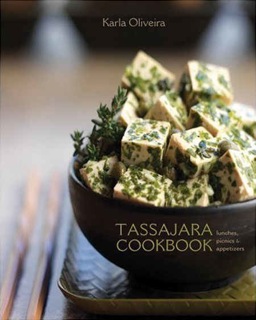
Ha! It’s vegetarian, and I still brought it home. Brought it home and got completely wound up in what were starting to sound like really good spreads and chutneys, even without any meat: Fennel Mustard Butter, Tarragon Onion Spread, Eggless Egg Salad, Mushroom Pâté… I had to look up what “tempeh” was, and what “tamari” was (coarse tofu and a kind of soy sauce, respectively) and then designed a menu mindful of chardonnay:
Tempeh Garlic spread with cherry tomatoes
Artichoke, Walnut Tofu spread with Raincoast crisps
Un Mondo Cacciatore Hunter’s Style dried salami & grainy mustard
Cabbage slaw with maple vinaigrette
Coco-Luxe chocolate truffles
Ultimately, though I forgot the forks and the sun refused to shine in Napa (inconceivable!), this picnic was a smash. We uncorked a thoughtfully chilled 2007 Chardonnay, dressed the salad, sliced the salami, and enjoyed our picnic despite the chilly breeze. In fact, I’m not sure it could’ve been nicer– the spreads were good protein but not so filling that we would regret them at dinner time, the slaw added a vinegary, crunchy element and the truffles at the end effectively sealed off any overindulgence in white wine. Only the sun was lacking to make our view out over the vineyards perfect.